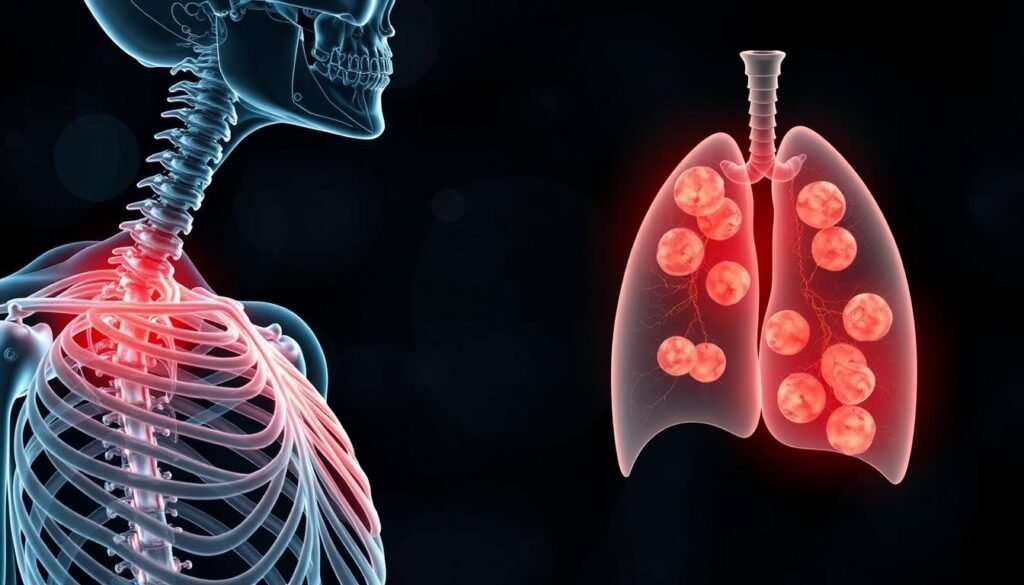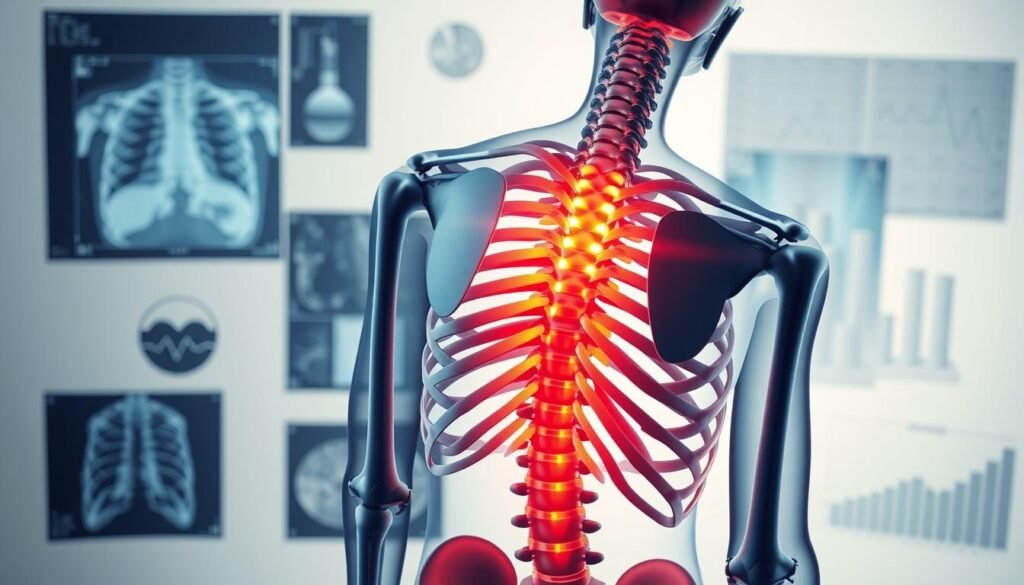Did you know non-small-cell lung cancer often spreads to bones? This can lead to severe bone pain, a key sign of the illness for some. As the disease gets worse, the pain can too, hurting the patient’s quality of life. This guide shows how to handle the pain caused by lung cancer. We talk about what causes this pain and the symptoms. We also explore ways to manage pain, including drugs and other care options. Our goal is to improve the life of those dealing with this kind of lung cancer.
Key Takeaways
- Lung cancer often spreads to bones, causing significant pain.
- Bone pain can be the initial sign of metastatic lung cancer.
- Effective pain management requires a combination of therapies.
- Diagnostic tests like MRIs and X-rays are crucial in identifying symptoms.
- Supportive therapies, including relaxation techniques, enhance pain control.
- A healthy diet and exercise can bolster bone health.
Understanding Lung Cancer and Bone Pain
Lung cancer is a major health issue worldwide, starting in the lungs and often going unnoticed. Many don’t see signs until the cancer spreads, known as lung cancer progression. Symptoms include a continuous cough, chest pain, losing weight without trying, and feeling very tired. Spotting these symptoms early can help catch the disease sooner, which is key for treatment.
Defining lung cancer and its progression
Lung cancer has two main kinds: non-small cell lung cancer (NSCLC) and small cell lung cancer (SCLC). These types can spread, leading to bone metastases. Research shows more than 30% of patients with late-stage lung cancer will experience bone spread. This results in a lot of pain and worsens life quality. The pain from bone metastases is essential in planning treatment.
The significance of bone pain in lung cancer patients
Bone pain is common when lung cancer spreads to bones. The pain might focus on the back, hips, and other important areas. As the cancer gets worse, the pain can increase too. Between 35% to 60% of NSCLC patients who initially don’t have bone metastases might get it later. Recognizing symptoms of bone issues allows for better treatment plans, focusing on the cancer and pain relief.
In the end, spotting lung cancer signs and knowing about bone pain’s impact is crucial. With focused management strategies, health workers can better assist those fighting lung cancer and ease their journey.
Causes of Lung Cancer Bone Pain
Lung cancer often causes significant pain due to bone spread. About 30% to 40% of people with advanced lung cancer will see it spread to their bones. It’s vital to understand how bone lesions form and affect the body to manage pain well.
Metastatic lung cancer and skeletal metastases
Bones are the third most common place lung cancer spreads, after the liver and adrenal glands. Pain usually shows up first, in about 80% of patients with bone spread. The spine, ribs, and femur are often affected. Cancer cells in bones weaken them, which can lead to breaks. Plus, a dangerous condition called hypercalcemia can happen, bringing more health issues.
Understanding bone lesions and their effects on the body
Bone lesions from metastatic lung cancer are seen as osteolytic, sclerotic, or mixed. Each type shows how the disease is moving. Sclerotic lesions tend to grow slower and are less linked to hypercalcemia. Where these lesions are can change symptoms a lot. Pain, weakness in legs, or changes in feeling can happen, especially with spine lesions.
Impact of treatments on bone health
Treatments try to lessen symptoms and make life better but can affect bone health. Chemotherapy and immunotherapy, for example, might make bones weaker, raising the risk of breaks. Painkillers and corticosteroids are key for pain relief. Delaying the disease and improving comfort is critical in metastatic lung cancer. More details on this subject can be found in this detailed review.

| Type of Bone Metastasis | Description | Associated Symptoms | Common Treatments |
|---|---|---|---|
| Osteolytic | Bone destruction due to cancer cells | Severe pain, higher fracture risk | Pain relief, radiation therapy |
| Sclerotic | Bone formation around tumor sites | Localized pain, often less severe | Pain management, bisphosphonates |
| Mixed | Combination of osteolytic and sclerotic features | Varied pain presentation, potential complications | Customized pain and treatment plans |
Symptoms and Diagnosis of Bone Pain in Cancer
Lung cancer patients may feel different kinds of bone pain. Spotting these signs early is crucial for choosing treatments. It hugely impacts how well patients do. Symptoms to watch for include:
- Localized discomfort
- Swelling in the affected area
- Tenderness of the bones
- Weakness leading to increased fracture risk
- Unexplained fatigue
- Weight loss
Noticing these signs early can help manage pain better. This makes life better for patients. Catching these lung cancer bone pain signs early also helps in diagnosing cancer faster.
Recognizing the symptoms of lung cancer bone pain
Symptoms can be different for everyone. Pain that stays, especially at night, is a key warning. Any new or worse pain, swelling, or soreness needs attention.
Diagnostic tests for identifying cancer-related bone pain
Finding the cause of bone pain needs accurate tests. Common ones include:
- X-rays
- CT scans
- MRI scans
- Bone scans
- Bone marrow biopsies
These tests show if cancer has reached the bones, helping doctors pick the best treatment. Diagnosing cancer often uses imaging and biopsies. This confirms cancer in the bones and ensures patients get the care they need.

Cancer Pain Management Strategies
Managing pain is key, especially for lung cancer patients. It involves pharmacological strategies and non-pharmacological strategies. These are chosen based on what each person needs. Using both approaches helps improve life for those with pain, like bone pain.
Pharmacological approaches to managing pain
Doctors often use drugs like opioids and anti-inflammatory meds for cancer pain. Pain relief drugs include:
- Acetaminophen
- NSAIDs such as ibuprofen
- Opioids like hydrocodone, oxycodone, and fentanyl
These drugs are tailored to how severe the pain is, which is scored from 0 to 10. Sometimes, doctors might add meds like stimulants or anticonvulsants. These help with specific problems and lessen side effects.
Some people may get devices like pain pumps, which provide relief directly.
Non-pharmacological approaches for holistic care
Using non-drug methods along with medicine offers complete care. Such techniques include:
- Physical therapy
- Relaxation and mindfulness
- Acupuncture and hypnosis
- Heat or cold packs
These help with the mental and emotional sides of pain. Providers should customize care for each person’s unique situation. For more info, see this resource.

Opioid Analgesics for Severe Pain Relief
Opioid analgesics are key in managing severe pain for lung cancer individuals. They block brain pain signals. This is very important to better the lives of these patients. Morphine is often chosen, but doctors might pick different drugs based on what works best for the patient.
Understanding opioid analgesics and their role
Knowing how opioid analgesics help is critical. They change the game for people with advanced lung cancer.
About 75% of these patients deal with ongoing pain. This makes opioids like oxycodone or morphine vital. The doses of these drugs are personalized to fit each patient’s reaction. Sometimes, even with ongoing treatment, sudden pain can still happen. This is why adjusting doses is key.
Managing side effects of opioid medications
While opioids are helpful, their side effects are not. Issues like constipation, nausea, and being dizzy can affect the patient’s comfort. Patients and doctors need to keep an eye on these effects together. This ensures pain relief while keeping side effects bearable.
Using opioids with medicines like acetaminophen or ibuprofen may improve pain relief. It can also mean needing less opioids, which could reduce side effects.
| Opioid Analgesic | Typical Starting Dose | Maximum Dose | Common Side Effects |
|---|---|---|---|
| Morphine | 15-30 mg orally every 4 hours as needed | Up to 200 mg daily | Constipation, nausea, drowsiness |
| Oxycodone | 5-10 mg orally every 6 hours as needed | Up to 80 mg daily | Dizziness, vomiting, itching |
| Hydromorphone | 0.2-1 mg intravenously every 2-3 hours as needed | Up to 24 mg daily | Confusion, constipation, headache |
| Fentanyl | 12-25 mcg/hr transdermally | Up to 100 mcg/hr | Sleepiness, nausea, sweating |
Doctors need to teach patients about overdose risks like small pupils and weird breathing. It’s important they know when to get help fast. Making a full pain plan that suits each person offers the best chance for good pain control and fewer side effects.
Radiation Therapy and Its Role in Pain Management
Radiation therapy is key in reducing pain for lung cancer patients with bone metastases. It uses high-energy rays to shrink tumors in the bones. This helps ease the pain caused by cancer spreading to bones.
How radiation therapy targets bone metastases
Healthcare providers use precise doses of radiation to decrease cancer cells in bone metastases. This shrinkage reduces the tumor size, easing the pain. The pressure on nearby nerves is lessened, which helps in pain relief.
A study showed that one dose of 8 Gray (Gy) radiation can relieve pain as effectively as several doses. But, single-dose treatments might increase the chance of fractures. Thus, treatments like percutaneous vertebroplasty, along with radiation, can improve pain control and keep the spine stable for patients with spinal metastases.
Potential side effects of radiation treatment
Although radiation therapy helps manage pain, it’s important to know about the side effects. Skin irritation, fatigue, and localized discomfort are common. Knowing these risks helps patients and doctors manage treatment better.
Pain relief strategies and close monitoring for side effects are vital for those being treated for bone metastases. For more about using radiation therapy in lung cancer treatment, visit radiation therapy for lung cancer.
| Parameter | Single Fraction Treatment | Multiple Fraction Treatment |
|---|---|---|
| Dose of Radiation | 12 or 16 Gy | 30 Gy over 10 sessions |
| Efficacy in Pain Relief | Equivalence to multiple fractions | Effective |
| Alleviation of Bone Pain | 2 weeks, 3 months, 9 months | Measured at similar intervals |
| Recurrence Rates | Lower at 1 and 2 years | Higher compared to single-dose group |
| Pathological Fracture Rates | Higher but not statistically significant | Lower rates |
Use of Bisphosphonates and Denosumab in Treatment
Dealing with metastatic bone disease means finding the best therapies to ease pain and lower complication risks. Bisphosphonates and denosumab play a big role in making things better for patients. Knowing how they work and their advantages helps treat this disease well.
Benefits of bisphosphonates in metastatic bone disease
Bisphosphonates are key in fighting bone metastases found in breast, prostate, and lung cancers. They go after areas in the bone that are changing too fast. These changes are slowed down by keeping osteoclasts—cells that break down bone—in check. Treatments like zoledronic acid and disodium pamidronate help keep bones strong and lessen symptoms in patients.
A systematic review showed that bisphosphonate therapy not only brings down bone-related problems. It also helps with pain management. Since 70% to 80% of breast and prostate cancer patients suffer from bone metastases, bisphosphonates are important in their treatment plans.
Exploring denosumab as a treatment option
Denosumab is a strong treatment for bone issues from various cancers. It stops osteoclasts from working, which keeps bones from getting weaker. Research reveals that denosumab really helps with pain and makes life better for people with metastatic bone disease. It’s especially good for patients who are not in a lot of pain yet, making it a key option in treatment strategies.
Together, bisphosphonates and denosumab give doctors powerful ways to manage bone metastases. They make a big difference in the quality of care for patients, leading to better experiences and outcomes.
Palliative Care: Improving Quality of Life
Palliative care is key to better life quality for lung cancer patients. It helps with physical symptoms and emotional needs early on. This care, when added to regular treatment, lessens pain and distress. It makes life better for patients and their families. This all-around care is crucial, especially with the hard parts of advanced lung cancer.
The importance of early palliative care interventions
Starting palliative care early leads to better results. A review showed up to 64% of patients with late-stage disease feel pain. This pain adds to emotional struggles like anxiety and depression. So, getting help early is very important. Palliative care teams have doctors, nurses, and social workers. They provide care that fits what the patient needs. This can change how one handles cancer’s challenges.
Integrating emotional and spiritual support
Palliative care goes beyond just physical pain. It includes help for emotional and spiritual healing. Cancer patients often feel they don’t spend enough time with doctors. They are also confused about their treatment plans. Palliative care improves communication and offers counseling. This helps patients and families feel listened to and supported. It helps with anxiety and depression, improving life quality. It shows how vital emotional support is in lung cancer treatment.